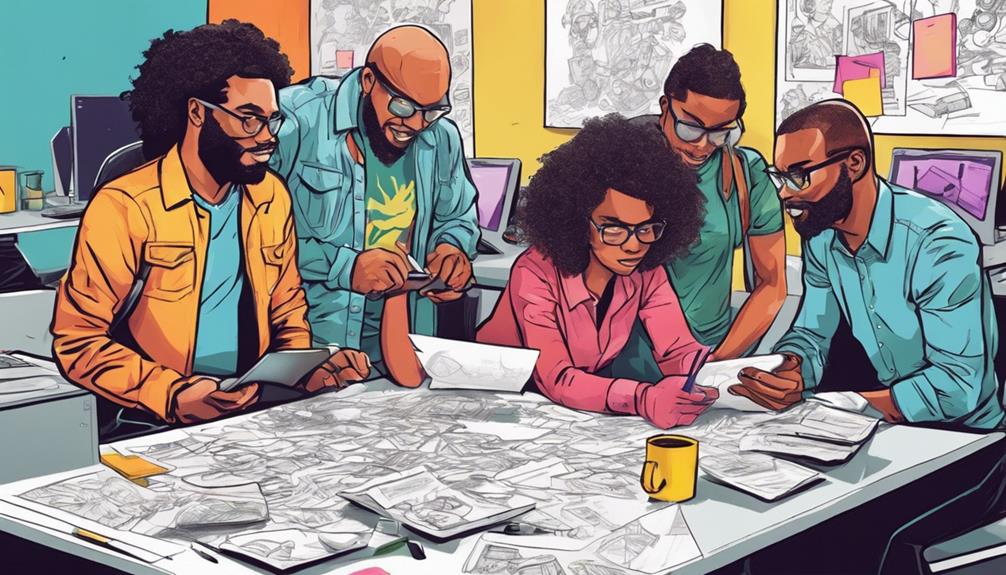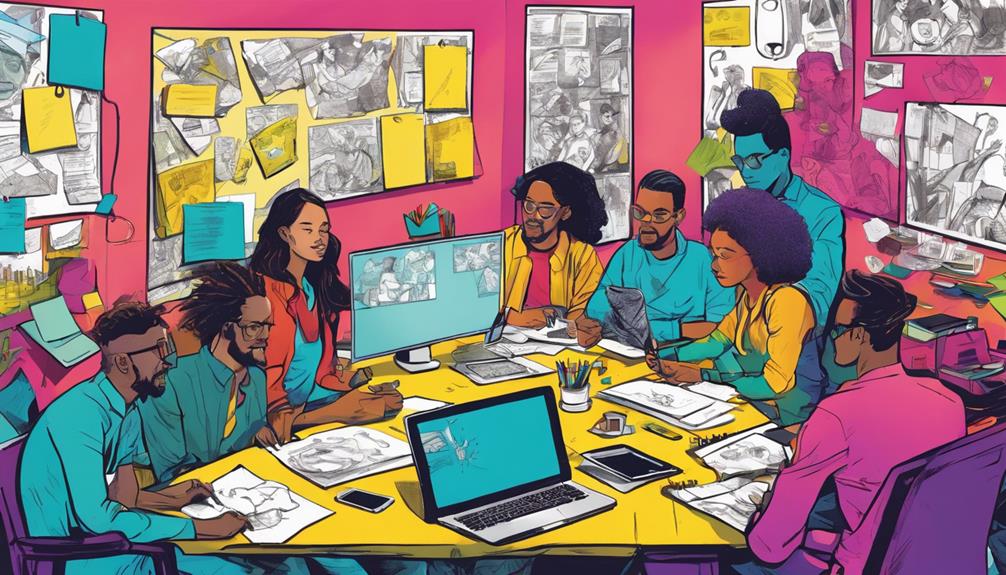To guide innovation and change with design thinking, spark creativity, empower teams, and nurture a culture of innovation. Effective leadership is crucial to steering projects to success, fostering innovative thinking, and embodying design principles. Confront team dynamics, challenges, and emotional obstacles directly with strong leadership. Assist teams with transparent communication, resources, and a secure environment for ideas. Provide guidance, establish new idea environments, and embrace failure for continuous improvement. Design thinking in banking guarantees adaptability to market changes and customer-centric solutions. For a more in-depth exploration of design thinking leadership, delve into the strategies, benefits, and practical applications shared in the research.
Key Takeaways
- Foster a culture of creativity and innovation.
- Empower teams to drive change through design thinking.
- Lead by example in embracing new methodologies.
- Provide resources and support for innovative projects.
- Implement design thinking principles to inspire and guide teams.
Importance of Effective Leadership
Effective leadership plays an important role in guiding design-thinking projects to success. In the field of design thinking, leadership isn't just about giving orders but about inspiring and empowering teams to think innovatively and problem-solve creatively. Leadership in design thinking involves not only understanding the methodology but also embodying its principles of empathy, experimentation, and collaboration.
Leadership training is vital for senior executives to effectively enable and support design teams. These leaders need to champion a culture that embraces design thinking methods, even if they challenge traditional problem-solving approaches. They must foster an environment where iterative prototyping and testing are encouraged, promoting a mindset that sees failure as a stepping stone towards success.
For employees unfamiliar with design thinking, strong leadership is necessary to provide guidance and support. Leaders must lead by example, demonstrating a willingness to learn and adapt to new methodologies.
Challenges Faced by Project Teams

You may encounter challenges in project team dynamics, resistance, and managing emotional hurdles in design thinking initiatives.
Overcoming resistance to new methodologies and shedding preconceptions can be tough but important in this process.
Emotional flare-ups and uncertainties are common, so it's essential to navigate through them effectively for project success.
Project Team Dynamics
Moving through the challenges faced by project teams in design-thinking projects requires a deep understanding of team dynamics and potential hurdles that may arise.
In design-thinking projects, leadership processes play a pivotal role in addressing the wants and needs of team members. Employees accustomed to rationality and objectivity may find methods like empathizing with users challenging. Shedding preconceptions about products or services can be a struggle for team members engaging in design-thinking projects.
Anxieties arising from design-thinking findings have the potential to derail projects, leading to emotional flare-ups and uncertainties among team members. The iterative nature of prototyping and testing in design-thinking approaches may cause employees to feel like they're spinning wheels.
Effective leadership is essential in guiding project teams through these challenges, ensuring that team dynamics are managed effectively to drive innovation and change.
Overcoming Resistance
To overcome resistance in design-thinking project teams, addressing inherent challenges head-on is essential for progress and success. Design-thinking methods, such as empathizing with users, may initially appear subjective, posing a challenge for project teams accustomed to more concrete processes. Employees grappling with letting go of preconceptions about products or services can hinder the smooth flow of design-thinking projects.
The anxieties stemming from design-thinking findings have the potential to derail project progress if not managed effectively. Emotional flare-ups and uncertainties are common within design-thinking teams, requiring strong leadership to navigate through these turbulent waters. Additionally, the iterative nature of design-thinking approaches might give project teams the false impression of minimal progress, leading to frustration and resistance.
Managing Emotional Challenges
Managing emotional challenges in design-thinking projects demands a profound understanding of team dynamics and individual responses to the iterative and subjective nature of the process.
Teams can feel overwhelmed by the constant need to empathize with users, leading to anxiety and uncertainty.
Emotional flare-ups often arise during the prototyping and testing phases, impacting team morale and productivity.
Adapting to the unconventional approaches of design thinking can provoke frustrations and uncertainties, causing team members to feel like they're trapped in a cycle of intense emotions.
Recognizing and addressing these emotional challenges is essential for leaders to guarantee team cohesion and project success.
Leadership Strategies for Support

As you explore leadership strategies for supporting design thinking initiatives, consider the importance of adopting supportive approaches that foster creativity and innovation.
Providing guidance and mentorship to your team can help navigate the complexities of design thinking projects effectively.
Supportive Leadership Approaches
Supporting design thinking teams effectively requires leaders to create an environment that fosters innovation and collaboration. To achieve this, leaders should:
- Encourage Open Communication: Facilitate open discussions where team members feel comfortable sharing their ideas and perspectives without fear of judgment. This open communication fosters creativity and allows for the free flow of innovative concepts within the team.
- Provide Resources and Support: Leaders should guarantee that teams have access to the necessary resources, tools, and support needed to explore new ideas and concepts effectively. By supplying the right resources, leaders empower teams to turn their innovative ideas into actionable solutions.
- Promote Psychological Safety: Cultivate a culture where team members feel psychologically safe to take risks, experiment, and learn from failures. Psychological safety fosters creativity and risk-taking, which are essential elements of successful design thinking projects.
Guidance for Team Success
How can leaders effectively guide their teams towards success in design thinking projects?
To ensure your team thrives, create an environment that encourages the emergence of new ideas. Guide them through the various methodologies of design thinking, helping them navigate the process effectively. It's crucial to maintain a clear sense of direction and purpose throughout the project, keeping everyone focused on the end goal.
Support your team without stifling their creativity. Avoid micromanaging, as it can inhibit innovation. Instead, provide guidance and resources to empower them to explore new possibilities.
Embrace failure as a stepping stone to success, encouraging your team to learn from mistakes and iterate on their ideas. By fostering a culture that embraces experimentation and continuous improvement, you'll set your team up for success in design thinking initiatives.
Empowering Through Mentorship
To empower your team effectively through mentorship in design thinking leadership, focus on providing guidance and support as they navigate the complexities of the design process. Effective mentorship helps teams embrace failure, learn from iterative processes, and stay focused on the project's purpose.
Leaders empower teams by creating a conducive environment for new ideas to emerge and flourish. Mentorship encourages teams to navigate the challenges of design thinking and maintain a sense of direction. Guidance from leaders in design thinking projects is essential for teams to overcome uncertainties and emotional flare-ups.
Case Study: Crisis Management

During a design-thinking project focused on enhancing services, Anne Lind encountered a crisis that shifted perspectives towards prioritizing client needs over organizational efficiency.
The project unearthed a disconnect between organizational goals and client requirements, prompting a reevaluation of processes originally tailored to meet internal needs.
By immersing themselves in the experiences of clients, the project team realized the necessity of realigning services with client expectations.
This crisis underscored the crucial importance of ensuring that design-thinking projects are centered on meeting the needs and desires of the end-users.
It became evident that to drive successful innovation and change, organizations must prioritize understanding and addressing the concerns and preferences of their clients.
This shift in perspective not only transformed the direction of the project but also served as a valuable lesson in crisis management within the domain of design thinking, emphasizing the significance of aligning services with client expectations.
Benefits in Banking Sector

Design thinking in the banking sector plays a pivotal role in fostering an innovative ecosystem to adapt to evolving landscapes. Here are three key benefits of design thinking in the banking sector:
- Adaptation to Changing Landscapes:
Traditional industries like banking, facing regulatory reforms and financial crises, can benefit significantly from integrating design thinking approaches. This enables banks to stay agile and responsive to dynamic market conditions.
- Competitive Edge:
Banks, including industry giants like HSBC, have embraced design thinking to navigate challenges posed by new competitors and external shocks such as the global pandemic. This proactive approach helps them stay ahead of the curve in a rapidly evolving financial landscape.
- Customer-Centric Innovation:
Steve Suarez's Design Thinking Journey

Steve Suarez's journey into design thinking leadership at HSBC began with his role as the Global Head of Innovation, where he was dedicated to fostering a culture of creativity and problem-solving within the organization. To deepen his understanding, Suarez completed eight courses in Innovation and Entrepreneurship through Stanford Online. Subsequently, he developed a Design Thinking 101 course tailored for his colleagues at HSBC. This initiative proved successful, with over 5,500 individuals registering for the course. Due to Suarez's efforts, Design Thinking concepts were effectively introduced to the leadership at HSBC, marking a significant shift towards innovative practices within the company.
| Courses Completed | Platform | Institution |
|---|---|---|
| 8 | Stanford Online | Stanford |
Impact of Design Thinking Courses

The introduction of the Design Thinking 101 course at HSBC has greatly transformed the organization's approach to innovation and problem-solving. Steve Suarez's initiative to implement this program has had a significant impact, as evidenced by the following:
- Over 5,500 Registrations: The course's popularity is evident from the high number of registrations, showcasing the keen interest employees have in adopting design thinking principles.
- Practical Tips for Immediate Application: By offering practical advice that can be applied right away, the course ensures that participants can quickly implement their learnings in real-world scenarios.
- 1,700 Certificates Awarded: The impressive number of certificates granted indicates a substantial level of engagement and commitment from individuals who've completed the Design Thinking program.
The increasing enrollment in the course suggests a growing recognition of its effectiveness in driving innovation and problem-solving within HSBC.
Through this initiative, design thinking has become a cornerstone of the organization's success, yielding tangible results and fostering a culture of creativity and forward-thinking.
Frequently Asked Questions
What Are the 3 P's of Design Thinking?
The 3 P's of design thinking are People, Process, and Product. People involve understanding user needs. Process includes stages like ideation. Product focuses on creating solutions. These P's form the basis for successful innovation and change.
What Are the 5 Pillars of Design Thinking?
You've got the 5 pillars of design thinking: Empathize, Define, Ideate, Prototype, and Test. Each step guides you through understanding users, crafting solutions, and testing ideas. Embrace this framework for driving innovation and change.
What Are the 3 E's of Design Thinking?
To understand the 3 E's of design thinking, remember empathy, experimentation, and evidence-based decision-making. Dive deep into user needs, foster creativity through prototyping, and rely on data for informed choices. These E's drive innovation successfully.
What Are the 5 Steps of Design Thinking?
To answer your question about the 5 steps of design thinking, you'll want to remember Empathize, Define, Ideate, Prototype, and Test. These steps guide you through understanding users, framing problems, creating ideas, building prototypes, and testing solutions.
Conclusion
To sum up, as a leader in the ever-evolving landscape of design thinking, you must embrace change and foster innovation within your team. By utilizing effective leadership strategies and drawing inspiration from successful case studies, you can navigate through challenges and drive impactful change.
Remember, leadership isn't just about guiding the ship, but also about being the wind that propels it forward towards success.









